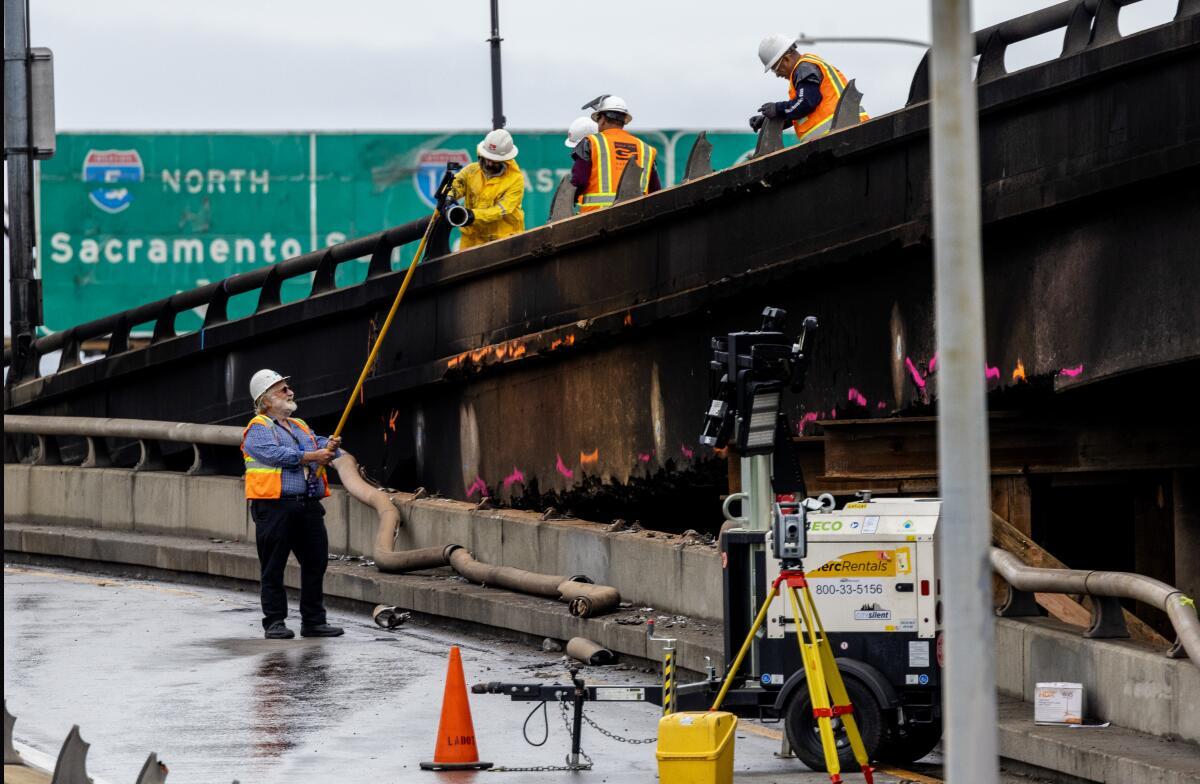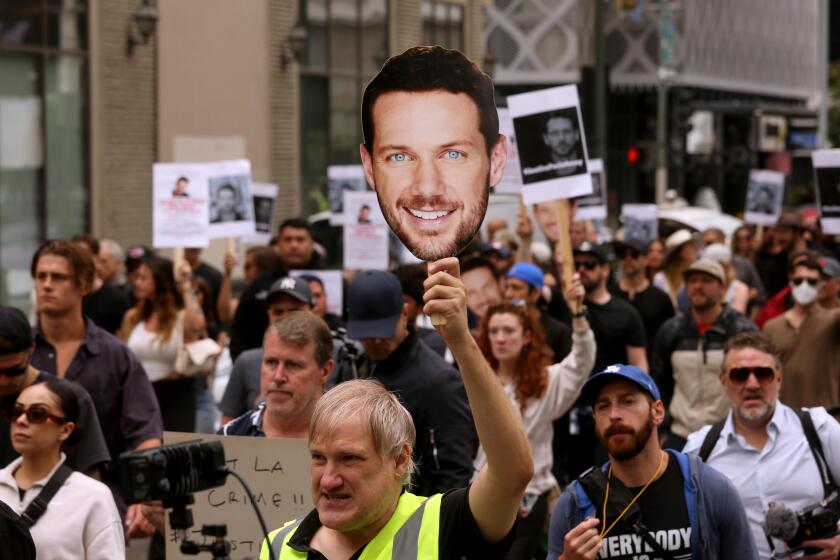He lost his business in a massive freeway fire a year ago. At 70, he’s starting over

On a recent chilly morning in Hesperia, Alfredo Lara used a shovel to pour cement into a mound of concrete he’d shaped like a wide volcano for mixing. Nearby, his friend filled a bucket with water for the final ingredient.
“Well, here we are, trying to carry on,” the 70-year-old said in Spanish. “But it hasn’t been easy at all, I’ve been really struggling.”
Just over a year ago, a massive fire erupted underneath the Santa Monica Freeway in downtown Los Angeles that damaged dozens of support columns, melted guardrails and caused millions of dollars in damage to the overpass. An arsonist was blamed for the fire, but no arrests have been made.
Though initially the freeway was expected to be closed for weeks, shutting down a vital transportation route for daily commuters and regional commerce, it reopened much faster than anticipated.
But for some of those who were hit hardest by the disaster, such as Lara’s junkyard business that was among roughly a dozen merchants operating under the freeway — recovery has been much slower. The concrete he was mixing on a recent Friday was going to be used to anchor fencing around his one-acre lot he purchased four months ago in Hesperia.

Before the fire, he and other migrant business owners were paying rent to their landlord, Apex Development Inc., a Calabasas-based company that leased the 48,000-square-foot triangular lot under the freeway from the California Department of Transportation and illegally sublet it to them, according to state records and officials.
At the time, Caltrans had sued Apex Development’s owner, Ahmad Anthony Nowaid, alleging he owed $78,000 in back rent for the lot. It was also one of five properties that Caltrans was attempting to evict Apex and another of Nowaid’s companies from, claiming he owed $620,000 altogether in unpaid rent.
Mainak D’Attaray, attorney for Nowaid, did not respond to a request for comment.
Lara, who paid $4,000 a month for his space on Nowaid’s lot, which he then subleased because it was costly, said he and others paid their rent until Caltrans told them not to. That prompted Nowaid to sue Caltrans for interfering with his business. A few months later, the fire erupted.
“I lost about $150,000 worth of property,” Lara said. “I had two tow trucks, a dozen or so vehicles including a Chevy truck and Ford truck from the 1970s.”
Lara said he and others got little help from the state and local officials. He said he applied for a low-interest federal disaster loan with the Small Business Administration, but there was no follow-up.
“I didn’t get a letter or a phone call from them,” he said.
Meanwhile, some who got loans complained that the amount was low.
Max Paxtor, who operated a recycling business, said he lost more than $200,000 in property in the fire but only received a $25,000 loan from the SBA. He said he had to borrow $45,000 from family and friends to rebuild his business. At least one merchant has sued Caltrans for negligence.
In a written statement, Caltrans said it is still in litigation on all lawsuits and declined to comment.
The SBA did not respond to multiple requests for comment.
Locally, however, the city’s Emergency Management Department established a recovery center to link business owners to much-needed resources.
Department officials said at least 117 business owners visited the center, of which 18 reported direct fire damage, 25 reported smoke damage and 104 businesses reported economic damage; some had all three.
Jennifer Lazo, the department’s coordinator and innovation and technology division chief, said that it partnered with City Council offices and business organizations to distribute information to people affected by the fire.

“More businesses may have been impacted that did not visit the center,” she said, “but received virtual assistance, or went directly to a business source center.”
Lazo said the department’s role was to convene resources and it’s the city’s Economic and Workforce Development Department and the federal SBA that are responsible for administering financial assistance to businesses.
In a written statement, the Economic and Workforce Development Department said staff from nearby resource centers spent four days canvassing the area and providing information about loans and services to people affected by the fire in English, Spanish and Korean.
“Staff outreached to 83 businesses during this period,” the statement read. “The goal was to ensure that businesses received the support and resources they needed to recover and rebuild.”
The department said at least five grants of up to $5,000 each were issued through a microenterprise grant program. The federal program requires that businesses have five or fewer employees, which may have disqualified some owners. Most merchants like Lara were self-employed.
The fire was a devastating blow for Lara and his wife, Sofia Cruz, 63. He was unable to work for two months, prompting him and his wife to dip into their life savings, spending all of the $15,000 they had saved up.
He said he used a tow dolly to pick up cars and haul them to salvage yards to make some money as he tried to rebuild.

Lara said the extreme stress and anxiety since the fire has caused colitis and depression. His wife often cries and chews her nails out of nervousness.
“She wasn’t sleeping, she wasn’t eating,” he said. “I tried to reassure her that things would be OK in the end.”
But the stress is taking its toll on Lara too. Poor circulation in his legs has turned his walk into more of a waddle. His said his feet get swollen, he is prone to headaches and getting a heavy feeling in his chest.
Short and paunchy with a stoic face and gray hair, Lara said he still puts on a brave face around his wife.
“You get sad, but you tell yourself those thoughts aren’t going to help,” he said, “You have to think about solutions instead.”
But when he is alone thinking about the weight of his debts, his wife’s health and their uncertain future, he cries.
“We’ve lived a hard life,” he said. “We’ve sacrificed so much.”
Lara came to the U.S. in 1992 from Zapopan, a town in the state of Jalisco, Mexico. He lived in a small apartment in Lincoln Heights, where his wife was also living at the time.
“We were neighbors,” he recalled. “We’d say hello to each other all the time.”
Those greetings turned into marriage vows. The pair worked and saved what they could so they could buy a house.
At one point, Lara got a job at a tow truck company, where he took an interest in starting his own business. His wife agreed to support him in making that happen.
Over the years, Lara said, his business grew and he was able to purchase a second tow truck that his wife operated.
“Those days were full of happiness and hope,” he said.
In November 2023, the couple walked into their new three-bedroom home in Apple Valley.
“I thought we had reached that moment in the story where you live happily ever after,” Lara said.
But hours after moving in, he said, he got a call from another merchant that all of their businesses were burning to the ground.



Aerial views of the 10 Freeway on Nov. 13, 2023 after a large pallet fire burned below, shutting the freeway to traffic. (Robert Gauthier / Los Angeles Times)
Since then, Lara was forced to take out a $25,000 business loan with a high interest rate. He also owes $75,000 to a friend who sold him a 2016 yellow, Ford F-650 bed truck.
“I was happy that I could get my business running again,” he said. “But then there’s the pressure of the debt.”
He recently purchased land in Hesperia after neighbors complained to the city about him using his Apple Valley home as a junkyard. He has a hearing scheduled and fears getting a fine. His focus now is to use his new property to haul cars from Fontana, Victorville, Pomona and Riverside. These days, the amount he receives per towed vehicle is less than the $600 he used to get years ago, adding another challenge.
At the vacant lot on a recent morning, Lara limped to the driver’s side of the bed truck, which has a cracked windshield. November was a difficult month and debts are mounting.
Last week, he and his wife decided to skip visiting family for Thanksgiving and opted to stay home.
“The $100 we spend for a family get-together can be $100 for our bills,” he said. “We have to keep paying our debts.”
Times researcher Scott Wilson contributed to this report.
More to Read
Sign up for Essential California
The most important California stories and recommendations in your inbox every morning.
You may occasionally receive promotional content from the Los Angeles Times.











